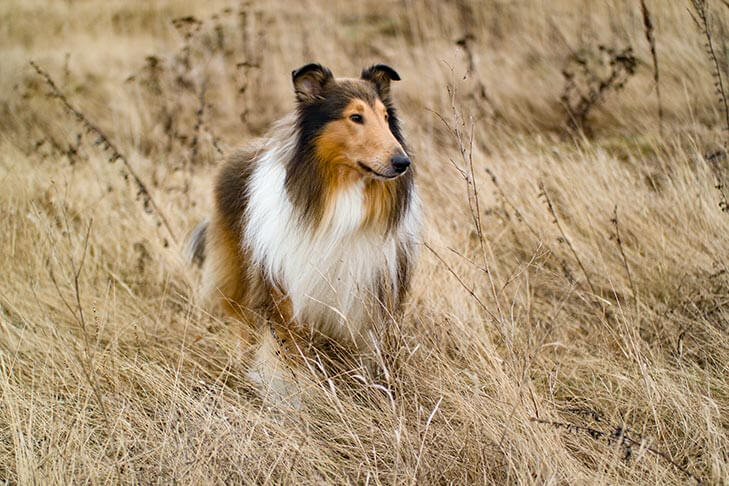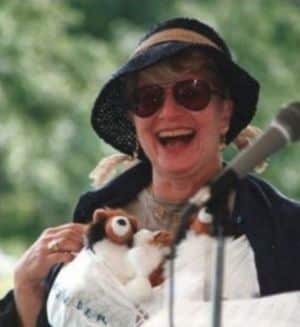There is a general consensus today among old-timers evaluating Collies (of which I am one) that there is a noticeable destruction of correct Collie expression, which is paramount to a dog being a good Collie.
“The Collie cannot be judged properly until its expression has been carefully evaluated.”
One of the first qualities that a “good” Collie judge studies is the expression of the animals being shown. It should be the ultimate factor in any decision.
“Expression is one of the most important points in considering the relative value of Collies.”
Today, correct Collie expression is being lost! Many new people in the breed do not recognize it as being correct when it is presented to them. The major emphasis today seems to be judging the Collie in profile with little or no value being given to expression. A Collie cannot be judged properly until it is looked in the face. This is the only way to see its expression.
There are several structural factors that are required for a Collie to have correct expression. The increasing acceptance of the change in the shape of the Collie muzzle is a major factor in the loss of the correct, sweet, melting Collie expression. The muzzle is the initial factor in creating the correct Collie head. Whether this change in the muzzle is done intentionally to make the profile lines sharper or is due to lack of knowledge or because it is what is winning, none of the reasons are valid.
Today’s flattening of the top of the muzzle (even simply flattening the muzzle just before the stop) and the narrowing of the muzzle… all contribute to the demise of the smooth, full, round muzzle called for in the Collie Standard. This loss must be judged as a serious fault, a fault of TYPE that is of major importance. It is a fault that detracts from the essence of the Collie.
The Standard gives a great amount of description to correct head properties and to the desired expression, which has “the necessary bright, alert, full-of-sense look that contributes so greatly to Collie expression.”
This expression is created when a “well-rounded muzzle” blends into the flat skull at the slight stop. The first element that is a MUST for a good head is a full, smooth, rounded muzzle. This roundness must be present, from the black nose until the stop. It helps to create the correct expression when it blends into the flat skull at the slight stop. The foreface will thus be “chiseled to form a receptacle for the eyes.”
The muzzle is the first element needed to have a correct Collie head, and thus, correct expression. It is the determining factor for the proportions of the head. The fullness of the muzzle and the length of the muzzle determine what will be the desired width and length of the backskull.
“The proper width of backskull necessarily depends on the combined length of skull and muzzle and the width of the backskull is less than its length. Thus the correct width varies with the individual and is dependent upon the extent to which it is supported by length of muzzle.”
Today’s head faults have become accepted because some breeders found that it was easier to win under all-rounders who only looked at the Collie in profile. Thus, a flat, straight muzzle, a definite stop, and a seemingly flat skull when the ears are up seem appealing when one does not look them in the face. Take a piece of paper and hold up the edge. Then make a round cone of the paper. A rounded edge gives a very different look than does a flat edge. It is a less precise outline.
Many Collie artists who exaggerate Collie characteristics as a means to express their artistic representation of the breed have exacerbated this fad. The Collie head cannot adequately show expression with a line drawing. It is easier to draw a correct profile than it is to draw correct expression. It is also easier to breed a correct profile if one does not demand a correct expression. The Standard only calls for an acceptable profile to have “the top of the backskull and the top of the muzzle lie in two approximately parallel, straight planes of equal length, divided by a very slight but perceptible stop” (emphasis mine). Many Collie fanciers are now breeding Collies that emulate these artists’ renditions of the Collie, not what the Standard states it should be.
Another factor that is essential to good expression is the structure of the skull. The sides of the skull and the top of the skull should feel as flat and smooth as glass. There should be no lumps or dips in the backskull: “The backskull is flat, without receding either laterally or backward.” The zygomatic arches should be flat, without any feeling of roundness to the bones. It should be equal in length to the muzzle.
Today, part of the problem in getting the correct expression is the trend to have the backskull at the same width as the muzzle. This gives the animal a pencil head. The Standard calls for the correct Collie head to be a slight wedge.
“Both in front and profile view the head bears a general resemblance to a well-blunted lean wedge, being smooth and clean in outline and nicely balanced in proportion. On the sides it tapers gradually and smoothly from the ears to the end of the black nose.”
Thus, in order to get the proper expression in a Collie, the head must be a slight, balanced wedge with a round muzzle that blends into a flat skull at the midpoint or stop. This will produce a foreface that is chiseled to form a receptacle for the eyes. The slight wedge allows the eyes to be “placed obliquely to give them the required forward outlook.”
If the Collie has a pencil head or lacks the rounded muzzle, it will have a very foreign expression. Often these animals have the eyes off to the side of the head, giving them the expression of a dead fish.
Another fad that has harmed the expression of the Collie is to have “too much stop.” Breeders brag about having a “nailed stop” in their dogs. Nowhere is this called for in our Standard. We want a “very slight but perceptible stop.” The Collie should have a one-piece head. If there is a definite stop, the result is a two-piece head. With too much stop, the eyes will be placed horizontally, not obliquely. If they are not placed obliquely, the expression will be startling and often vacant.
Many years ago, a big-winning Collie’s profile was on the cover of a magazine. My daughter asked why a Collie that looked like a Husky was on the cover. To prove her point, she took tracing paper, traced the profile, and put small prick ears on the drawing. She was right. Having seen the dog, I had to admit that the dog’s deep stop and short head did indeed give the dog a Husky-like expression.
The final structural element that contributes to a correct Collie expression is the size, placement, and shape of the eye. Placement of the eye is determined by the other three factors mentioned. However, the size of the eye is a separate inherited characteristic. The Standard calls for the eyes to be “almond shaped” and “of medium size.” They should “never properly appear to be large or prominent.”
Today, the trend is to have eyes that are TOO SMALL. “Medium” does not mean beady or squinty. The eyes reflect the soul of the Collie. Eyes that are too small give the dog an evil or blank look, which is the opposite of what is the essence of a good Collie. The Collie should never have the fierce terrier-like expression that is seen too often in the Collie ring today.
Correct Collie expression is difficult to describe, but once one has seen correct expression… has felt a full, round muzzle… has put one’s fingers on a slight but perceptible stop… has let the hands glide over the flat, smooth skull… has looked into the soul of the Collie, which is seen in the properly shaped and sized eye… it is an experience that will never be forgotten. It is what one should constantly strive for in breeding and should be a major factor in judging the Collie.
Are you looking for a Collie puppy?
The best way to ensure a long and happy relationship with a purebred dog is to purchase one from a responsible breeder. Not sure where to begin finding a breeder? Contact the National Parent Club’s Breeder Referral person, which you can find on the AKC Breeder Referral Contacts page.
Want to help rescue and re-home a Collie?
Did you know nearly every recognized AKC purebred has a dedicated rescue group? Find your new best friend on the AKC Rescue Network Listing.
Collie Dog Breed Magazine
Showsight Magazine is the only publication to offer dedicated Digital Breed Magazines for ALL recognized AKC Breeds.
Read and learn more about the graceful Collie dog breed with articles and information in ourCollie Dog Breed Magazine.
Error embedding FlippingBook shortcode, please check the flipbook url. (https://digital.showsightmagazine.com/view/709394/)









